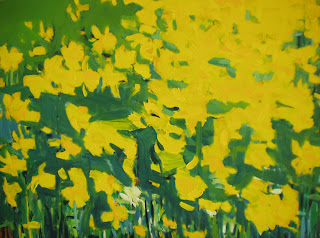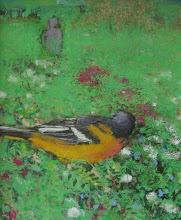
Edouard Manet's "Roses in a Champagne Glass," 12"x9", oil/canvas
During the year Manet was dying, he started doing small paintings of flowers. This is one. Though small, still it shows Manet's dashing brushstrokes and Velasquez-like Spanish coloring--blacks and deep greys mixed with bright color punctuations. There is a lovely book of the sixteen flower paintings done before his death in the spring of 1883, The Last Flowers of Manet, text by Andrew Forge. Mr. Forge points out that the tabletop here is the same one that the barmaid leans upon in "A Bar at the Folies-Gergere," his last major painting, completed a year before his death in the spring of 1883. In that complicated picture, there are two roses in a champagne glass in front of the barmaid.
I did a small flower painting yesterday, thinking of Manet. Grey winter is all around us here. The quick painting obviously nods to the one above, but has more paint and more inter-ference with the space around it, brighter color, less darkness.
Three roses in December, 12"x9," oil and pigment/board

































